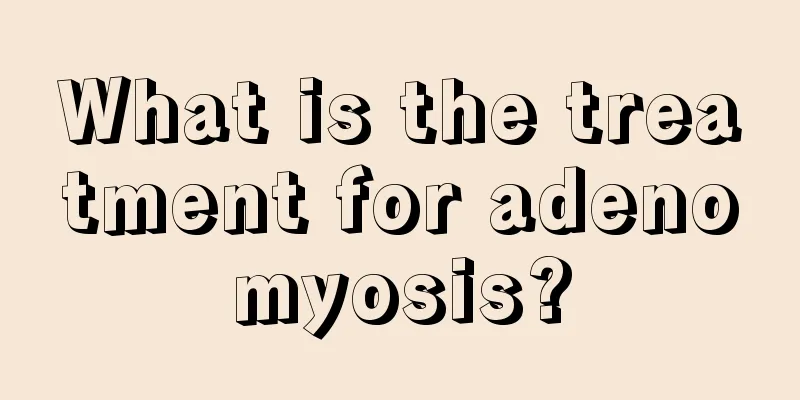What is the treatment for adenomyosis?

|
The uterus is one of the most important organs for female friends. It is the place for nurturing new life. Some people have bad living habits or do not take good care of themselves after giving birth, which will cause uterine diseases. So do you know about the disease of adenomyosis and how it is treated? Let’s take a look at the treatments of adenomyosis. 1. Medication (1) Symptomatic treatment For patients with mild symptoms who only require relief of dysmenorrhea symptoms, especially those near menopause, non-steroidal anti-inflammatory drugs can be used for symptomatic treatment during dysmenorrhea. Because the ectopic endometrium will gradually shrink after menopause, the pain of such patients will be relieved after menopause without the need for surgical treatment. (2) Pseudomenopause therapy GnRHa injection can make the hormone level in the body reach the menopausal state, thereby causing the ectopic endometrium to gradually atrophy and play a therapeutic role. This method is also called "medical oophorectomy" or "medical hypophysectomy." (3) Pseudo-pregnancy therapy: Some scholars believe that oral contraceptives or progestins can cause the ectopic endometrium to decidualize and atrophy, thereby playing a role in controlling the development of adenomyosis. However, some scholars believe that the ectopic endometrium of adenomyosis is mostly the basal layer of the endometrium, which is insensitive to progesterone. Therefore, the effect of progesterone in the treatment of adenomyosis remains controversial. 2. Surgery Including radical surgery and conservative surgery. Radical surgery is hysterectomy, and conservative surgery includes adenomyosis lesion (adenomyoma) resection, endometrial and myometrial resection, myometrial electrocoagulation, uterine artery occlusion, presacral neurectomy and sacral neurectomy. (1) Hysterectomy is used for patients who have no fertility requirements, whose lesions are extensive, whose symptoms are severe, and who have not responded to conservative treatment. Moreover, in order to avoid residual lesions, total hysterectomy is the first choice, and partial hysterectomy is generally not advocated. (2) Lesion resection for adenomyosis is suitable for patients who want to have children or are young. Because adenomyosis often has diffuse lesions and unclear boundaries with normal uterine muscle tissue, how to choose the method of resection to reduce bleeding, residual tissue and facilitate postoperative pregnancy is a very confusing issue. Different scholars have different plans, and there is currently no unified procedure. The above introduction is about the treatment methods of adenomyosis. I wonder if this knowledge is helpful to everyone. If you have a disease like adenomyosis, don’t be overly afraid or nervous. Go to a regular hospital for treatment so that you can recover. You should also pay more attention to your body in normal times and avoid overwork. |
<<: Explanation of infertility examination items for women
>>: How to get rid of stretch marks after childbirth
Recommend
Causes of urethral bleeding in women
Female urethral bleeding may be caused by urinary...
Wearing leather pants causes gynecological inflammation
Many girls like to wear leather pants, which repr...
What is baking makeup? What are the specific steps for baking makeup?
Try to choose a finer spray, which will have a be...
Are canned foods really “junk food”? That may be a little unfair… Eating them this way is healthier →
When it comes to canned food, many people think o...
What is the probability of an incomplete abortion?
These issues are rarely discussed. What is the pr...
What is the problem of Dendrobium not blooming? What should I do if Dendrobium does not bloom?
Dendrobium is a kind of flower that we often see ...
What are the methods to regulate kidney yang deficiency in women?
Women's unique physiological mechanisms cause...
What to do if you have uterine prolapse during pregnancy? Chinese and Western medicine treatment is effective
The main reason for uterine prolapse after pregna...
How much does a HEYTEA Trick or Treat Pumpkin bag cost? Is the HEYTEA Trick or Treat Pumpkin bag delicious? How does it taste?
We all know that every Halloween, HEYTEA launches...
What to do if your period is delayed for 10 days
Irregular menstrual periods are very common for w...
Is it useful to repair the uterus after abortion?
Under some special circumstances, female friends ...
Big forehead woman
In this appearance-oriented society, more and mor...
Four months pregnant, lower abdomen tearing pain
When a woman is four months pregnant, she has ent...
Causes of stomach pain before menstruation
Period is what we often call menstruation. During...
What causes brown discharge from a woman’s vagina?
Women's physical health is a very important m...









